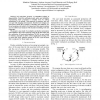Free Online Productivity Tools
i2Speak
i2Symbol
i2OCR
iTex2Img
iWeb2Print
iWeb2Shot
i2Type
iPdf2Split
iPdf2Merge
i2Bopomofo
i2Arabic
i2Style
i2Image
i2PDF
iLatex2Rtf
Sci2ools
102
Voted
ISCAS
2007
IEEE
2007
IEEE
Modeling of self-adaptive systems with SCADE
— An important property of embedded systems is dependability. Today this addresses mostly safety and reliability. Guaranteeing these properties is normally done by adding redundancy to the system. This approach is expensive and can not cope with changing environments. Therefore new designs are researched, which allow systems to self-adapt and self-heal. For broad acceptance in industry it is important, that organic systems can be modeled and analyzed with standard modeling tools and languages. We present a case study of an adaptive production automation cell modelled in the Lustre language using the SCADE Suite and the verification of functional properties. SCADE is used widely in industry, especially in safety critical applications. Being able to model and verify adaptive systems in SCADE could increase their acceptance for these target areas.
Related Content
| Added | 06 Jun 2010 |
| Updated | 06 Jun 2010 |
| Type | Conference |
| Year | 2007 |
| Where | ISCAS |
| Authors | Matthias Güdemann, Andreas Angerer, Frank Ortmeier, Wolfgang Reif |
Comments (0)

